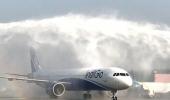One reason is that airlines have ramped up capacity and expanded their presence in tier-II markets.
The first of a three-part series analyses how the aviation industry is an outlier in the midst of an overall economic slowdown.
Aneesh Phadnis reports.
Illustration: Uttam Ghosh/Rediff.com

Despite the dismal start to the year with Jet Airways collapsing and domestic traffic slowing down, the aviation industry is showing signs of emerging from the doldrums.
Airlines flew more than 70 million passengers between January and June - a 3 per cent growth over last year.
Airline executives and analysts say they expect domestic air traffic to return to double digit growth in the next few months.
One reason is that airlines have ramped up capacity and expanded their presence in tier-II markets.
Growth turned negative in April with Jet’s demise but has picked up again with 2.8 per cent in May and a 6 per cent rise in June.
While the present demand is being driven by low fares as it is a seasonally weak quarter, fuel prices are lower compared to last year, bringing relief to carriers.
“After the Jet crisis, the reduction in capacity in the peak quarter saw a massive jump in fares and some sectors saw fare increases in excess of 30 per cent.
"The turbulence from the Jet crisis impacted the aviation sector and the domestic market witnessed low single digit growth rates in the first quarter of FY 2020.
"Growth rates are likely to bounce back into double digits shortly as significant capacity is being deployed by existing carriers,” said Balu Ramachandran, head of air and distribution at Cleartrip.com.
In the preceding quarter, airlines added 65-70 planes to compensate for the capacity lost by Jet’s closure.
The maximum number of planes - 31 - was brought in by SpiceJet. SpiceJet had plans to add 60 planes in FY20, but now has indicated it will add up to 13 in the winter season.
The capacity guidance has been lowered due to uncertainty around return into service for Boeing 737 Max aircraft.
“We look forward to their (Boeing 737 Max) swift return to service in the near future that will help SpiceJet increase its margins and provide a superior level of service,” SpiceJet chairman Ajay Singh said after announcing the firm’s record Rs 261-crore quarterly profit.
The pick-up
“Immediately after Kingfisher Airlines closure, we had seen a similar dip in traffic. But now it has already started picking up. For domestic, I can say it is at pre-April levels,” said GMR group’s deputy managing director I Prabhakara Rao.
IndiGo is expected to add 35 to 40 planes between August and next March while Tata group airlines AirAsia India and Vistara will add 20 planes.
While the first quarter saw airlines filling up the slots vacated by Jet in Mumbai and Delhi, most of the growth in the coming months is likely from non-metros and tier-II cities where the airlines are adding capacity.
Airlines are introducing destinations such as Silchar and Dibrugarh (IndiGo) and Bhopal, Gwalior, Jharsuguda, and Durgapur (SpiceJet).
Abroad, the additional destinations are Yangon and Hanoi (IndiGo) and Singapore and Dubai (Vistara).
Samir Patel, vice president (network planning), GoAir, said the airline had been growing at healthy double digits in the past and this would continue, without losing its focus on profitability and customer satisfaction.
“GoAir will take delivery of one aircraft every month on average. Newer routes are being developed.
"GoAir has added eight international markets and will continue to explore more routes,” said Patel.
Pricing issue
Pricing, however, remains a challenge for airlines.
The IndiGo management cautioned about lower yields in the second quarter after reporting a record Rs 1,203 crore profit in the first quarter of FY 2020.
“We do not expect any meaningful impact of Jet Airways to continue as all airlines have now replaced the capacity vacated by Jet.
"Unfortunately, we are witnessing some lower fares in the 0-15 day booking window and expect this to add some pressure to our unit revenue in the second quarter,” said IndiGo CEO Ronojoy Dutta.
On the positive side, the operating environment is more benign than last year.
Crude oil prices are lower in the second quarter on a year-on-year basis.
"Brent crude was $ 70 a barrel last year and now it is at $ 65.
"While there is a seasonal weakness, the lower fuel price is a silver lining,” said Santosh Hiredesai, analyst with SBICAP Securities.
Ameya Joshi who runs aviation website NetworkThoughts was optimistic.
“We could see a steady 8-12 per cent growth from October onwards and airlines may try to push up fares and look for profitability.”
Positive outlook
On international travel, demand remains positive.
“The near-term outlook remains positive as capacity allocation to other carriers in recent weeks has helped rationalise fares compared to the highs witnessed in the early quarters of this year.
"Also, the reopening of Pakistan's airspace and the consequent dip in air fares by 40 per cent will help revive demand for international travel,” said a MakeMyTrip spokesperson.
In the company’s latest annual report, Dutta talked of IndiGo’s future market targets.
“We are targeting countries that have high outbound tourist markets such as Russia, China and Israel and plan to start service to these countries soon.”
While United and Air Canada are resuming services to India, Virgin Atlantic is re-entering Mumbai following Jet’s closure. KLM is adding flights at Mumbai and Bengaluru.













 © 2025
© 2025